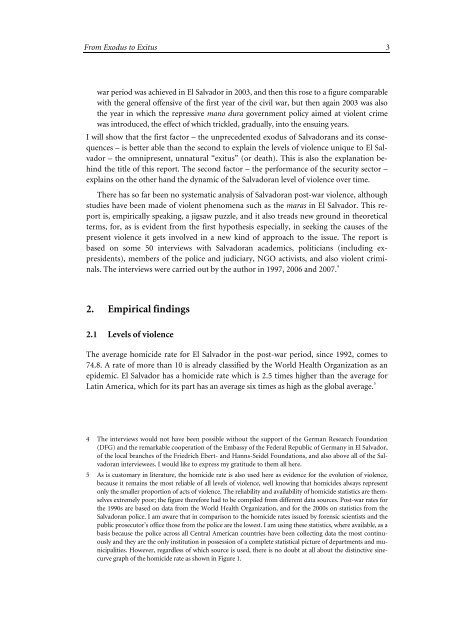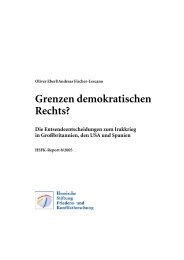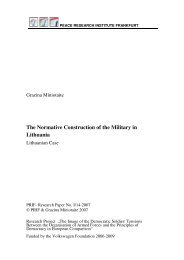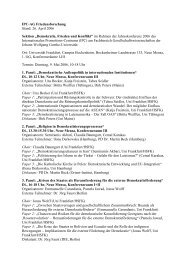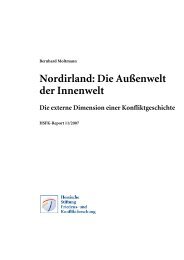From Exodus to Exitus Causes of post-war violence in El ... - eDoc
From Exodus to Exitus Causes of post-war violence in El ... - eDoc
From Exodus to Exitus Causes of post-war violence in El ... - eDoc
Create successful ePaper yourself
Turn your PDF publications into a flip-book with our unique Google optimized e-Paper software.
<strong>From</strong> <strong>Exodus</strong> <strong>to</strong> <strong>Exitus</strong> 3<br />
<strong>war</strong> period was achieved <strong>in</strong> <strong>El</strong> Salvador <strong>in</strong> 2003, and then this rose <strong>to</strong> a figure comparable<br />
with the general <strong>of</strong>fensive <strong>of</strong> the first year <strong>of</strong> the civil <strong>war</strong>, but then aga<strong>in</strong> 2003 was also<br />
the year <strong>in</strong> which the repressive mano dura government policy aimed at violent crime<br />
was <strong>in</strong>troduced, the effect <strong>of</strong> which trickled, gradually, <strong>in</strong><strong>to</strong> the ensu<strong>in</strong>g years.<br />
I will show that the first fac<strong>to</strong>r – the unprecedented exodus <strong>of</strong> Salvadorans and its consequences<br />
– is better able than the second <strong>to</strong> expla<strong>in</strong> the levels <strong>of</strong> <strong>violence</strong> unique <strong>to</strong> <strong>El</strong> Salvador<br />
– the omnipresent, unnatural “exitus” (or death). This is also the explanation beh<strong>in</strong>d<br />
the title <strong>of</strong> this report. The second fac<strong>to</strong>r – the performance <strong>of</strong> the security sec<strong>to</strong>r –<br />
expla<strong>in</strong>s on the other hand the dynamic <strong>of</strong> the Salvadoran level <strong>of</strong> <strong>violence</strong> over time.<br />
There has so far been no systematic analysis <strong>of</strong> Salvadoran <strong>post</strong>-<strong>war</strong> <strong>violence</strong>, although<br />
studies have been made <strong>of</strong> violent phenomena such as the maras <strong>in</strong> <strong>El</strong> Salvador. This report<br />
is, empirically speak<strong>in</strong>g, a jigsaw puzzle, and it also treads new ground <strong>in</strong> theoretical<br />
terms, for, as is evident from the first hypothesis especially, <strong>in</strong> seek<strong>in</strong>g the causes <strong>of</strong> the<br />
present <strong>violence</strong> it gets <strong>in</strong>volved <strong>in</strong> a new k<strong>in</strong>d <strong>of</strong> approach <strong>to</strong> the issue. The report is<br />
based on some 50 <strong>in</strong>terviews with Salvadoran academics, politicians (<strong>in</strong>clud<strong>in</strong>g expresidents),<br />
members <strong>of</strong> the police and judiciary, NGO activists, and also violent crim<strong>in</strong>als.<br />
The <strong>in</strong>terviews were carried out by the author <strong>in</strong> 1997, 2006 and 2007. 4<br />
2. Empirical f<strong>in</strong>d<strong>in</strong>gs<br />
2.1 Levels <strong>of</strong> <strong>violence</strong><br />
The average homicide rate for <strong>El</strong> Salvador <strong>in</strong> the <strong>post</strong>-<strong>war</strong> period, s<strong>in</strong>ce 1992, comes <strong>to</strong><br />
74.8. A rate <strong>of</strong> more than 10 is already classified by the World Health Organization as an<br />
epidemic. <strong>El</strong> Salvador has a homicide rate which is 2.5 times higher than the average for<br />
Lat<strong>in</strong> America, which for its part has an average six times as high as the global average. 5<br />
4 The <strong>in</strong>terviews would not have been possible without the support <strong>of</strong> the German Research Foundation<br />
(DFG) and the remarkable cooperation <strong>of</strong> the Embassy <strong>of</strong> the Federal Republic <strong>of</strong> Germany <strong>in</strong> <strong>El</strong> Salvador,<br />
<strong>of</strong> the local branches <strong>of</strong> the Friedrich Ebert- and Hanns-Seidel Foundations, and also above all <strong>of</strong> the Salvadoran<br />
<strong>in</strong>terviewees. I would like <strong>to</strong> express my gratitude <strong>to</strong> them all here.<br />
5 As is cus<strong>to</strong>mary <strong>in</strong> literature, the homicide rate is also used here as evidence for the evolution <strong>of</strong> <strong>violence</strong>,<br />
because it rema<strong>in</strong>s the most reliable <strong>of</strong> all levels <strong>of</strong> <strong>violence</strong>, well know<strong>in</strong>g that homicides always represent<br />
only the smaller proportion <strong>of</strong> acts <strong>of</strong> <strong>violence</strong>. The reliability and availability <strong>of</strong> homicide statistics are themselves<br />
extremely poor; the figure therefore had <strong>to</strong> be compiled from different data sources. Post-<strong>war</strong> rates for<br />
the 1990s are based on data from the World Health Organization, and for the 2000s on statistics from the<br />
Salvadoran police. I am a<strong>war</strong>e that <strong>in</strong> comparison <strong>to</strong> the homicide rates issued by forensic scientists and the<br />
public prosecu<strong>to</strong>r’s <strong>of</strong>fice those from the police are the lowest. I am us<strong>in</strong>g these statistics, where available, as a<br />
basis because the police across all Central American countries have been collect<strong>in</strong>g data the most cont<strong>in</strong>uously<br />
and they are the only <strong>in</strong>stitution <strong>in</strong> possession <strong>of</strong> a complete statistical picture <strong>of</strong> departments and municipalities.<br />
However, regardless <strong>of</strong> which source is used, there is no doubt at all about the dist<strong>in</strong>ctive s<strong>in</strong>ecurve<br />
graph <strong>of</strong> the homicide rate as shown <strong>in</strong> Figure 1.


